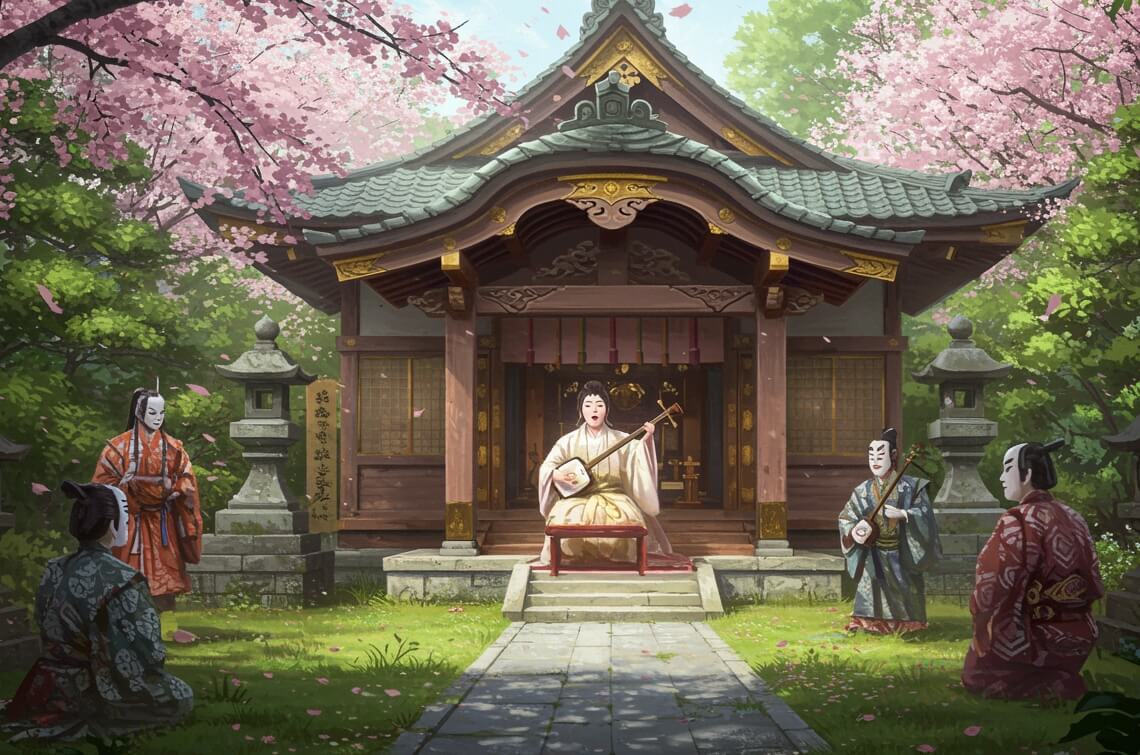Article index
Traditional Japanese music as a multisensory journey
Imagine finding yourself in an ancient Japanese temple, surrounded by the scent of incense and the rustle of the leaves moved by the wind. Suddenly, silence is interrupted by an ethereal voice that begins to sing, accompanied by the delicate sound of a Shamisen. This is only the beginning of your journey into the fascinating and complex world of traditional Japanese music.
Hogaku , as traditional music is called in Japan, is a millennial art that has its roots in the history and culture of the country of the Rising Sun. Unlike western music, which often tries to be an art in its own right, Hogaku is deeply intertwined with other artistic forms, creating a unique multisensory experience.
"Japanese music is like a Zen garden," explains the musicologist Shigo Kishibe in his book "The Traditional Music of Japan". "Every sound, every pause, has a precise meaning and contributes to creating a unique harmony".
One of the most surprising characteristics of the Hogaku is the predominance of the cantata voice. Since ancient times, the Japanese have given great importance to singing, as evidenced by Kojiki, the oldest document written in Japanese, which contains the texts of 113 songs.
 Utaimono and Katarimono: the two souls of Japanese vocal music
Utaimono and Katarimono: the two souls of Japanese vocal music
Japanese singing is divided into two large categories: Utaimono and Katarimono. Utaimono, literally "sung things", is a song similar to our songs. In this style, the melody is the main element, while the text takes on a secondary role. Singers often use melisms, or embellishments, creating a hypnotic and engaging effect.
Katarimono than to the actual song. In this style, the text is the central element and the music adapts to its natural inflections. "In Katarimono, every word is like a brushstroke in a painting," says singer Junko Ueda in an interview with Japan Times. "Our task is to bring out the profound meaning of the text through our voice".
To fully appreciate these two musical forms, I recommend you listen to two emblematic songs:
1. For Utaimono : "Sakura Sakura", a famous Japanese popular song that celebrates the flowering of cherries.
2. For the Katarimono : here is "Tanuki and the traveler", this Japanese popular story tells the story of Sakuzō, a traveler who falls victim to a joke of a Tanuki, a legendary creature of Japanese folklore.
Hogaku and other arts: perfect harmony
One of the most fascinating characteristics of traditional Japanese music is its close link with other art forms. It is not uncommon to attend shows in which music, theater, dance and poetry merge into a single, extraordinary experience.
The Nō theater, for example, is accompanied by Yōkyoku, a musical form that combines singing and acting. The Bunraku, the puppet theater, is inseparable from Gidayūbushi, a type of musical narrative that gives the characters voice. And in Kabuki, the Japanese popular theater, nagute music creates the atmosphere and underlines the key moments of the representation.
To experiment with this fusion of arts, I advise you to look at an extract from the show "Yoshitsune Senbon Zakura" of the Kabuki Theater, available on the official Youtube channel of the Japan National Theater. Observe how music is perfectly intertwined with the movements of the actors and the scenography, creating a totalizing experience.
A sound journey through time
Traditional Japanese music is not a static art, but a living organism that has evolved over the centuries. From Gagaku, the ancient court music imported from China in the seventh century, to the modern interpretations of Hogaku who incorporate elements of western music, every genre tells a part of Japanese history.
For a chronological journey through Japanese music, I suggest you explore the "Japanese Traditional Music" playlist.
In conclusion, traditional Japanese music is much more than a simple succession of notes. It is a journey through the history, culture and soul of Japan. As the composer Turu Takemitsu writes in his essay "Comparison Silence", "Japanese music does not try to dominate silence, but to be part of it". And perhaps this is precisely the secret of its timeless charm.
National Theater of Japan website , where you can find detailed information on the various traditional musical genres and on the show of the shows.
That your journey into traditional Japanese music is full of discoveries and sound wonders.
Happy listening!
Albert
[Divider Style = "Solid" Top = "20 ″ Bottom =" 20 ″]
Read also the article: #4 There is always a time for ...
[Divider Style = "Solid" Top = "20 ″ Bottom =" 20 ″]
Log in to all resources to
better understand this article
Log in to the exclusive SIING PLUS material
Or support us
Plus
Newsletter Siing Plus
Facebook private group
Private telegram
Private group WhatsApp
20%
discounts on all products and events organized by
Siing Production and Solos MediaAccess to all articles of the 7 platform planets
Access to all video courses, handouts, tutorials
4 numbers of the online magazine Siing Magazine 2025
Plus
Newsletter Siing Plus
Facebook private group
Private telegram
Private group WhatsApp
20%
discounts on all products and events organized by
Siing Production and Solos MediaAccess to all articles of the 7 platform planets
Access to all video courses, handouts, tutorials



 Utaimono and Katarimono: the two souls of Japanese vocal music
Utaimono and Katarimono: the two souls of Japanese vocal music




